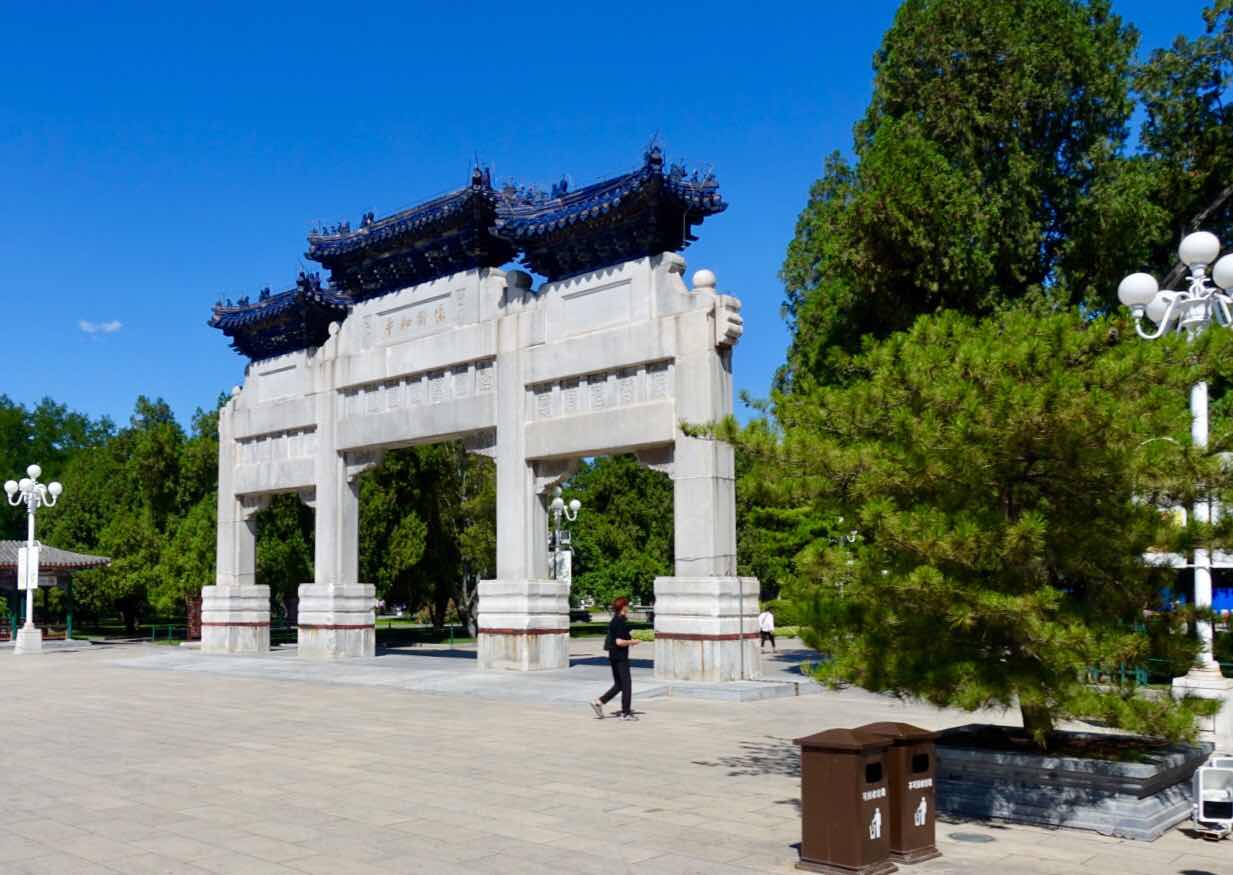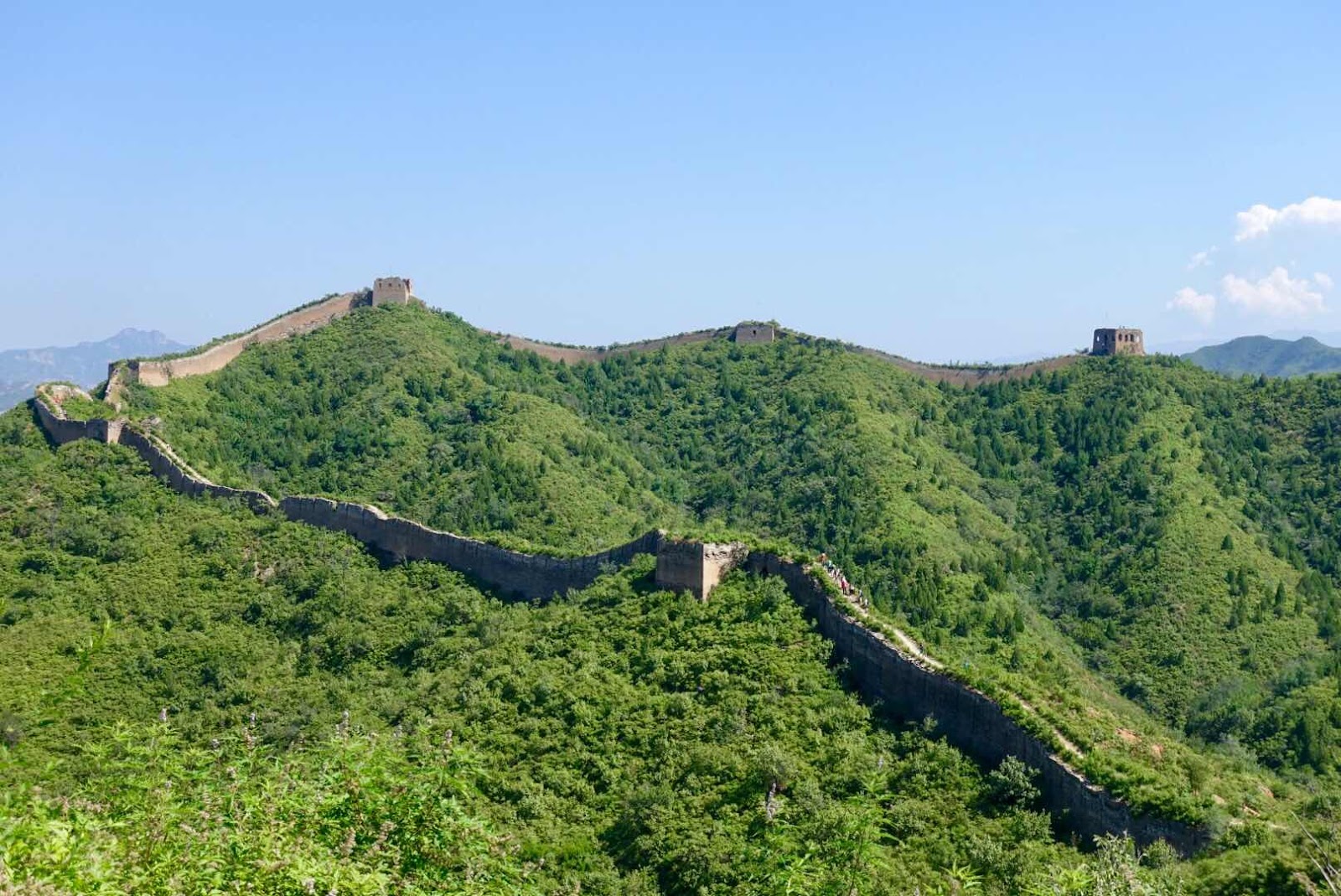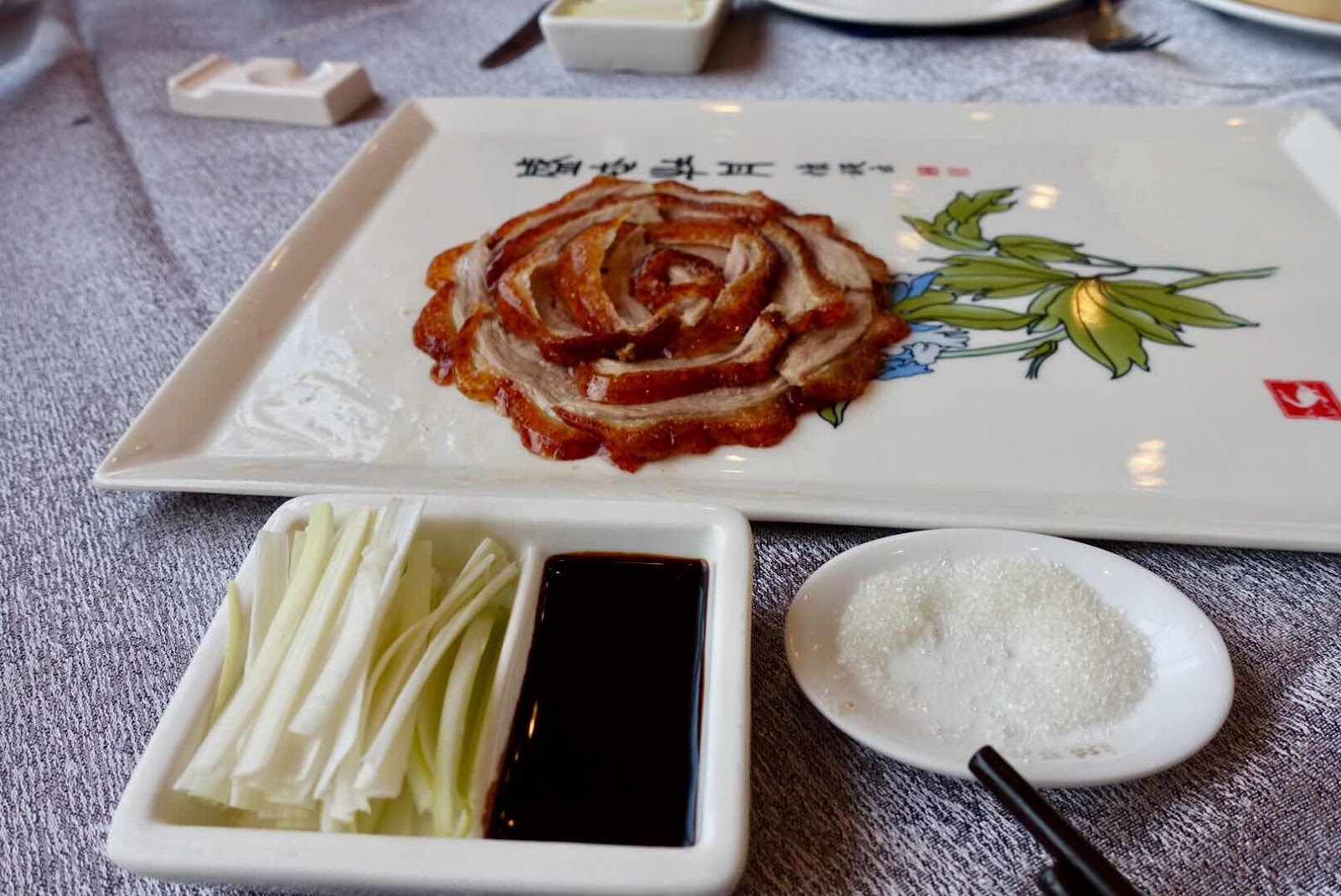Around the World for a Third Time (Beijing, Shanghai and Wuzhen)
(A Forbidden City vast courtyard in which the masses of tour groups appear less large)
Beijing
We afforded ourselves a limo and driver from the airport traveling throughout China, not only because in that country it is relatively affordable, but also to avoid language problems when arriving in crowded airports with luggage and being besieged by strangers offering to “help”.
(Police watching is always fun)


(another policeman standing like a frozen statue)
(China’s National Centre for the Performing Arts changes colors at night as if drifting on water)
Beijing is a very, very large city with “officially” 22 million citizens, predominantly Han chinese, driving 5 million cars within the 17,000 sq.km/ 6,600sq.mile city limits, while building every year 65,000 sq.km /25,000sq.mile new construction, mostly vertical floor space of course. I assume that has to end one day.
(Inside picture of the Arts Centre)

(More pictures of this building)
Of course I have to rely on Chinese data and China has learned the art of bragging for good reasons, because the modern world as we know it has arrived in China and unemployment is below 4%, again their official records.
(Flower beds surrounding Tiananmen Square)
(The wood construction and the colors never cease to amaze me)


(Mega Screens galore)
(The first entrance gate to Jingshan park)
(Mega Screens galore)
Stores carry every well known brand in the world and mega screens advertise these brands downtown making you believe you are in Manhattan, if it was not for the fact that one walks amidst masses of Chinese shoppers.
(And then less then a mile away thousand year old giant gate doors)

(Picture shooting gawkers like us within the forbidden city)
(1000 plus year old water spout modeled from clay, adorning roof tiles of the same age)

(if there is one thing that one will remember of the forbidden city, it is size and dwarfing height)
We spent our first day visiting the forbidden city, walking from our hotel and getting pleasantly lost for awhile, as we gawked at the buildings, streets, people, cops etc.etc. We found Tiananmen Square closed off, which seems to happen often. This time because in the huge state buildings, that line the square, an international conference between Chinese and African world leaders was ongoing, kicking off the Chinese Road and Belt Initiative, by which China hopes to financially enslave the recipients of their benevolence.
(Always struck by the wonders of nature like this century old tree)

(Seniors doing their Tai Chi exercises can be witnessed all over China)
(Bamboo lined walking path in the park)
(Jingshan Park courtyard where one can seek solitude)
(The 52 meter moat around certain parts of the city had to be wide enough to make archery shots and/or cannon ball shots ineffective. China had invented gunpowder before the year 1000)
To enter the forbidden city area, we had to pass a checkpoint that required ID’s, something we had not been prepared for. Luckily Sandee stores stuff like that on our iPhones. We wandered to the entrance of a city park called Jingshan, for which to our surprise even Chinese were paying an entrance fee. Inside the park was an underwhelming orchid exhibition, again demanding entrance fees, which we would not have paid for, if we had known its content.
(Emperors’ official grand hall reception area with golden throne, in the Palace of Supreme Harmony)
Ambling through the park we stumbled on the gates to the forbidden city, where we found a guide who led us through the vast grounds, recanting tales of Emperors, Eunuchs and Concubines (at times of wealth, numbering 3000 or more, quite a few of them dying as virgin “spinsters”, because the emperor never came around to bed them in his lifetime. By the way, 24 emperors occupied the forbidden city.
(The Queens reception Hall and throne, with above her a sign stating “do nothing”, which meant to say that sometimes it is better not to act and to let things progress as they will)
An Emperor, it was believed, would live longer if he had more sex with different women as long as he did not come. Which is wise, because only his Empress and 8 official wives were to give him children
It was the Eunuchs who ran the household, scheduling the emperors day, electing his meals and selected the ladies for the nightly activity, while allotting the emperor 2 hours only, because he should not be too tired the next morning for his full workday. Because of the time limit, ladies were sent naked into the emperors chambers. Yes lady readers, the Eunuchs really thought the Emperor needed the whole two hours.
(Scholars rock, a karstic limestone formation, highly admired as being inhabited by immortal beings)
(Behind the forbidden city is a man made hill of material removed during the construction of the forbidden city that now has a pergola and delivers great views of the compound)
Our guide pointed out heavy stones on the various courtyards, strategically placed to prevent possible tunneling by villains trying to murder the emperor. It took 1000,000 laborers and 100,000 craftsmen and 15 years to complete the forbidden city in 1420. And it burned down one year later, requiring 23 more years to rebuild.
She also told her personal story, which seems not to be uncommon in today’s China: being in her late 20’s she chose her own husband instead of having her parents involved or the Chinese matchmaker. He is an engineer in government employ and because of that deployed elsewhere most of the time, so much so, that she sees him only a few weeks a year. So romance waned and she was intending to divorce a few years ago, as her guide profession allows her independence, when she got pregnant of her second girl during one of the short visits of her husband.
(Above and below pictures of the free tea ceremony, in the hope we would buy tea)

(The resident calligrapher designing our love calligraphy, with my name in small print on the left and Sandee’s on the right)
She brought us to a tea ceremony, which is much more relaxed than the Japanese version. Also we met a “famous” calligrapher, who created our personalized love calligraphy, which now adorns our home. We took a metro back and used the metro the next day to visit at the city edge the Summer Palace, which turned out to be a dilapidated disappointment, frequented by thousands of Chinese, as it was a Saturday, picnicking in the park or boating on the formerly royal lake.
(Pictures of the Summer Palace, Above dependencies, Below the palace)
(A stone imperial gondola at the edge of the imperial lake frequented by Chinese weekend boaters)
That evening we partook in a food tour organized by Lost Plate, riding us on three or five wheel open pedicabs through the famous Beijing Hutongs
from dive to dive where we sampled different cuisines, like Hot Dried Noodles, Door Nail Meat Buns, Spring Cakes and Mongolian BBQ with “endless” beer, ending up in a brewery, which we skipped in order to get at 10.15 pm the last metro back. The city government want the citizens to sleep in early it seems.
Hutongs by the way were originally stratified neighborhoods circling the emperors forbidden city, with the highest ranking classes within the first circles and the last and furthest out circles of neighborhoods populated by the laborers and servants, but always low rise buildings, as no one should have higher roof lines than the emperor, a symbolism of servitude.
(Don’t remember which dish this is)


(Another dish)
(Our pedicab)
(Another dish)
(Walking the Hutong between little restaurants)
The next morning early we took a taxi to the outskirts of town. Actually only to ring road nr 4 out of 6, which 12 mile/20kmfrom the city center to a Starbucks, where I fatefully had signed up with the Beijing hiking club for a chinese great wall hike, away from the tourist trap everybody visits.
(I don’t know why I show you the Hiking Club bus)
(The beginning of the Sandee Hiking Saga, walking up to the great wall gate at Gubeikou)

(The first stairs - they look good and easy)
That turned out a disaster for us oldies. The 34 participants ranging from 20 to our age (we met a few couples in their sixties, apparently in better shape than we were), took a bus a 100km out of town to the city of Gubeikou, where we scrambled onto a portion of the Panlongshan Great Wall, that seemed in ok shape, only to find out in about 10 minutes, that that was one of the better portions of the wall.
(This is the fourth hill to climb under worsening conditions)

(The big fort on the right of picture is the end goal)
(Sandee straggling on as the trooper she is, mumbling curses at me)
We straggled, accompanied by one of the hiking club members for about 4 of the 8 km, seeing our hiking companions disappear in the distance up and down boulders and narrow pathways with the luring potential of falling of an edge to broken bones or worse.
(Almost at the first crumbling fort)

(The view around us are amazing)
Sandee was feeling her legs buckle at times and was not to happy with me. At the 4 km point, there was a path leading off the wall to a restaurant, the designated end station of the hike, which we took over the protestations of the club member who urged us to try a bit further.
(Back in the civilized world longing for the bus)
(A Hutong View Street)
Well in the bus on the way back, as is the prevailing logic of these times, we also were awarded the pin “I climbed the great wall” like everybody else. It now features on our safari hats.
(Tiananmen Square)
(Garden border around the Square, highlighting the Road and Belt Initiative)

(Collapsible Crowd Barricade Barriers, that prevented us earlier to walk the square, always on standby)
Our last day we rested and walked the now open Tiananmen Square and had the famous Peking Duck for lunch in the same restaurant Mao often frequented with his guests for the same dish he so dearly loved.
(Tribute to the “liberating workers”)
(I love those flowerbeds)

(Another policeman at work, at least he can walk up and down)
We wished it would have been less fatty, with the crispy skin it clearly lacked, to only find out, that after we ate some of the better pieces, a deep fried carcass arrived at the table for gnawing. Apparently we had to finish the whole duck. But canines we are not, so we stared at it and asked for the bill.
(Peking Duck being cut for us)

(The presented Duck dish with salt and scallions)
(Waiter showing is the obvious way to eat the dish, without touching the food)
 I
I
(And here are the bones to gnaw at)
Shanghai
(Modern Shanghai seen from the river cruise boat)
The city of the mile long Bund, where every tourist must go, alongside the river Huangpu, is known for its imposing early 20th century architecture and offers a pleasant stroll on sunny days. This is the city where we took a hop on hop off bus which we rode for 2 days on all routes, to get the best overview of the city, that is showing a mix of very sleek modern buildings to the old almost haunting style districts of yesteryear. And we took the obligatory river cruise.
(The Bund lines the river on the other side of the boat)
(Above and below the 20th century imposing buildings of the rich trading houses of those days)
Lunch at the “3 on the Bund” restaurant, outside on the rooftop was a pleasant surprise: they served carpaccio, decent spare ribs and broiled sea bass. After weeks of Chinese food, it tasted better than it most likely was.
(City view from the hop on hop off)
(Heping Park or Peace Park Shanghai)


(Don’t have a clue what it is and why it is there)
(More Park pictures, that are so asiatic. Still don’t know how to distinguish Japanese from Chinese park)


The most interesting part of the visit was the 5 floor Urban Planning Exhibition hall, with a whole floor dedicated to a 1/500 scale model of the city. The exhibition shows the present and future Shanghai and was the most interesting part of our visit to Shanghai.
(The Urban Planning Exhibition maquette; just amazing)

Wuzhen
(Our fast train to Wuzhen, with reserved seats and all. You are only allowed on the train platform a few minutes before train arrival)


(The thousand year old wooden buildings clearly show recent upkeep and are occupied by shops)
(Wuzhen during the day was full of Chinese tourists enjoying sweets and ice cream)
(The thousand year old wooden buildings clearly show recent upkeep and are occupied by shops)
Since we were close to the ancient water cities region, we decided to take a train to one of those cities, Wuzhen. The “Golden Triangle” of historical towns also known as the “Venice of the East” has more than a thousand year history. Many of those cities lie along the Grand Canal, which connected the city of Hangzhou with Beijing in the North. The canal was build around the year 600 to provide grain to Beijing to feed the army and its citizens there, as they protected the country against marauding Mongols.
(More views of this 7000 year old town with a patron saint of Tea, and famous for its silk trade)

(Wuzhen is a UNESCO world heritage Centre)
(Found out the school system here during the Qing dynasty produced more successful candidates to the highest imperial examinations for top positions in the empire than any other city in the land )
The town of Wuzhen feels like a Colonial Williamsburg visit and was overrun by Chinese tourists, although at night with the buses gone, it was very pleasant to stroll the streets and take a chinese gondola.
(My handiwork shown “proudly” in 2 photos)

(And here is “miss perfect” and her work)
We had a clay pottery lesson that highlighted our non artistic skills once again.
(Evening shots of Wuzhen after the crowds had gone)
(We took a gondola tour at night to get these pictures)
( the city was serene with only here and there restaurant noises)
Our return by fast train to Shanghai ended our 3 week visit to China.
Most of which I still need to tell you about.
Comments
Post a Comment